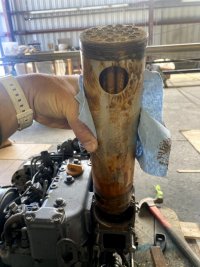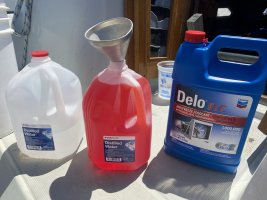I'm seeking experience/opinions on the use of radiator flush products in a marine diesel coolant loop.
After being out of the water for four months, a great amount of sediment/sludge has settled out of the coolant in my engine.
My internet research suggests that some possible explanations for the sludge include:
1. Unspecified corrosion in the coolant loop.
2. Mistaken mixing of different coolant types (causing additives to 'drop out')
3. A leaking head gasket allowing oil to pass into the coolant.
#3 is potentially a death knell for the motor.
The sludge I have found has no oily quality, the engine oil itself is not milky, and the sludge I have found settled to the bottom of various parts of the system (recovery tank, heat exchanger) rather than floating on top, as one might expect lighter-than-water oil to do. So I'm going with explanation 1 or 2 and seeing what happens.
To date, my coolant strategy has been, "Motor seems to be working, let's go sailing." As in, I have not replaced it since I bought the boat in late 2019 and put about 45 hours on the engine.

So, my plan at this point is to try to clean/flush the coolant entirely, and re-fill with manufacturer-specified coolant etc.
Has anyone ever used a radiator flush fluid product on his/her marine diesel? Like:
As to the usefulness of the flushing liquid, the internet predictably offers a range of opinion, from, "That won't work fer nuthin'" to "My good man you will irretrievably damage your combustion engine."
If I do not use the flush liquid, my plan will be to jerry-rig a garden hose flush of the heat exchanger, (I have already pulled the central element and cleaned the tubes.) This is the part (and all of the loop around the engine block) that is difficult to clean without flushing:

Tap water is "ionized" so after garden hosing, a subsequent draining and flush with distilled water would follow, then properly-mixed coolant replacement.
After being out of the water for four months, a great amount of sediment/sludge has settled out of the coolant in my engine.
My internet research suggests that some possible explanations for the sludge include:
1. Unspecified corrosion in the coolant loop.
2. Mistaken mixing of different coolant types (causing additives to 'drop out')
3. A leaking head gasket allowing oil to pass into the coolant.
#3 is potentially a death knell for the motor.
The sludge I have found has no oily quality, the engine oil itself is not milky, and the sludge I have found settled to the bottom of various parts of the system (recovery tank, heat exchanger) rather than floating on top, as one might expect lighter-than-water oil to do. So I'm going with explanation 1 or 2 and seeing what happens.
To date, my coolant strategy has been, "Motor seems to be working, let's go sailing." As in, I have not replaced it since I bought the boat in late 2019 and put about 45 hours on the engine.

So, my plan at this point is to try to clean/flush the coolant entirely, and re-fill with manufacturer-specified coolant etc.
Has anyone ever used a radiator flush fluid product on his/her marine diesel? Like:
Amazon.com: Prestone AS105 Radiator Flush and Cleaner - 22 oz.: Automotive
Buy Prestone AS105 Radiator Flush and Cleaner - 22 oz.: Radiator - Amazon.com ✓ FREE DELIVERY possible on eligible purchases
www.amazon.com
As to the usefulness of the flushing liquid, the internet predictably offers a range of opinion, from, "That won't work fer nuthin'" to "My good man you will irretrievably damage your combustion engine."
If I do not use the flush liquid, my plan will be to jerry-rig a garden hose flush of the heat exchanger, (I have already pulled the central element and cleaned the tubes.) This is the part (and all of the loop around the engine block) that is difficult to clean without flushing:

Tap water is "ionized" so after garden hosing, a subsequent draining and flush with distilled water would follow, then properly-mixed coolant replacement.




